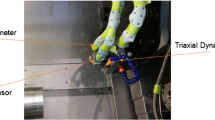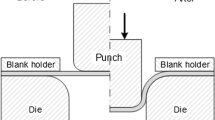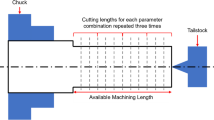Abstract
The modelling of machining processes by means of machine-learning algorithms is still based on principles that are especially adapted to mechanical approaches, in which very few inputs are varied with little repetition of experimental conditions. These principles might not be ideal to achieve accurate machine-learning models and they are certainly not aligned with the practicalities of industrial machining in factories. In this research the effect of a new strategy to improve machine-learning model accuracy is studied: experimental repetition. Tool-life prediction in the face-turning operations of AISI 1045 steel discs, depending on different cooling systems and tool geometries, is selected as a case study. Both the side rake and the relief angles of HSS tools are optimized using the Brandsma facing test under dry, MQL, and flooding conditions. Different machine-learning algorithms, such as regression trees, kNNs, artificial neural networks, and ensembles (bagging and Random Forest) are tested. On the one hand, the results of the study showed that artificial neural networks of Radial Basis Functions presented the highest model accuracy (11.4 mm RMSE), but required a very sensitive and complex tuning process. On the other hand, they demonstrated that ensembles, especially Random Forest, provided models with accuracy in the same range, but with no tuning procedure (12.8 mm RMSE). Secondly, the effect of an increased dataset size, by means of experimental repetition, is evaluated and compared with traditional experimental modelling that used average values. The results showed that some machine-learning techniques, including both ensemble types, significantly improved their accuracy with this strategy, by up to 23%. The results therefore suggested that the use of raw experimental data, rather than their averaged values, can achieve machine-learning models of higher accuracy for tool-wear processes.









Similar content being viewed by others

References
Abainia, S., & Ouelaa, N. (2015). Experimental study of the combined influence of the tool geometry parameters on the cutting forces and tool vibrations. International Journal of Advanced Manufacturing Technology, 79(5–8), 1127–1138. https://doi.org/10.1007/s00170-015-6885-9.
Abiodun, O. I., Jantan, A., Omolara, A. E., Dada, K. V., Mohamed, N. A., & Arshad, H. (2018). State-of-the-art in artificial neural network applications: A survey. Heliyon, 4(11), e00938. https://doi.org/10.1016/j.heliyon.2018.e00938.
Aha, D., & Kibler, D. (1991). Instance-based learning algorithms. Machine Learning, 6, 37–66. https://doi.org/10.1023/A:1022689900470.
Amini, M., & Chang, S. (2018). A review of machine learning approaches for high dimensional process monitoring. In IISE annual conference and expo (pp. 390–395).
Antony, J., & Kaye, M. (2000). Analysis and interpretation of data from Taguchi experiments. In Experimental quality. Boston: Springer. https://doi.org/10.1007/978-1-4615-5293-2_9.
Arnaiz-Gonzalez, A., Fernandez-Valdivielso, A., Bustillo, A., & Lopez de Lacalle, L. N. (2016). Using artificial neural networks for the prediction of dimensional error on inclined surfaces manufactured by ball-end milling. International Journal of Advanced Manufacturing Technology, 83(5), 847–859. https://doi.org/10.1007/s00170-015-7543-y.
Benardos, P. G., & Vosniakos, G. C. (2002). Prediction of surface roughness in CNC face milling using neural networks and Taguchi’s design of experiments. Robotics and Computer-Integrated Manufacturing, 18(5–6), 343–354. https://doi.org/10.1016/S0736-5845(02)00005-4.
Breiman, L. (2001). Random forests. Machine Learning, 45(1), 5–32. https://doi.org/10.1023/A:1010933404324.
Bustillo, A., Díez-Pastor, J.-F., Quintana, G., & García-Osorio, C. (2011). Avoiding neural network fine tuning by using ensemble learning: Application to ball-end milling operations. International Journal of Advanced Manufacturing Technology, 57(5), 521–532. https://doi.org/10.1007/s00170-011-3300-z.
Bustillo, A., Grzenda, M., & Macukow, B. (2016). Interpreting tree-based prediction models and their data in machining processes. Integrated Computer-Aided Engineering, 23(4), 349–367. https://doi.org/10.3233/ICA-160513.
Bustillo, A., Pimenov, D. Y., Matuszewski, M., & Mikolajczyk, T. (2018). Using artificial intelligence models for the prediction of surface wear based on surface isotropy levels. Robotics and Computer-Integrated Manufacturing, 53, 215–227. https://doi.org/10.1016/j.rcim.2018.03.011.
Bustillo, A., Pimenov, D. Y., Mia, M., & Kapłonek, W. (2020). Machine-learning for automatic prediction of flatness deviation considering the wear of the face mill teeth. Journal of Intelligent Manufacturing. https://doi.org/10.1007/s10845-020-01645-3.
Chandrasekaran, M., Muralidhar, M., Krishna, C., & Dixit, U. (2010). Application of soft computing techniques in machining performance prediction and optimization: A literature review. International Journal of Advanced Manufacturing Technology, 46(5), 445–464. https://doi.org/10.1007/s00170-009-2104-x.
Cuka, B., & Kim, D.-W. (2017). Fuzzy logic based tool condition monitoring for end-milling. Robotics and Computer-Integrated Manufacturing, 47, 22–36. https://doi.org/10.1016/j.rcim.2016.12.009.
Da Silva, F. J., Franco, S. D., Machado, A. R., Ezugwu, E. O., & Souza, A. M. S., Jr. (2006). Performance of cryogenically treated HSS tools. Wear, 261, 674–685. https://doi.org/10.1016/j.wear.2006.01.017.
Davim, J. P. (2008). Machining: Fundamentals and recent advances. Machining Fundamentals and Recent Advances. https://doi.org/10.1007/978-1-84800-213-5.
Debnath, S., Reddy, M. M., & Yi, Q. S. (2014). Environmental friendly cutting fluids and cooling techniques in machining: A review. Journal of Cleaner Production, 83, 33–47. https://doi.org/10.1016/j.jclepro.2014.07.071.
Dogra, M., Sharma, V. S., & Dureja, J. (2011). Effect of tool geometry variation on finish turning: A review. Journal of Engineering Science and Technology Review, 4(1), 1–13.
Grzenda, M., & Bustillo, A. (2013). The evolutionary development of roughness prediction models. Applied Soft Computing, 13(5), 2913–2922. https://doi.org/10.1016/j.asoc.2012.03.070.
Grzenda, M., & Bustillo, A. (2019). Semi-supervised roughness prediction with partly unlabeled vibration data streams. Journal of Intelligent Manufacturing, 30(2), 933–945. https://doi.org/10.1007/s10845-018-1413-z.
Grzenda, M., Bustillo, A., Quintana, G., & Ciurana, J. (2012). Improvement of surface roughness models for face milling operations through dimensionality reduction. Integrated Computer-Aided Engineering, 19(2), 179–197. https://doi.org/10.3233/ICA-2012-0398.
Günay, M., Korkut, I., Aslan, E., & Seker, U. (2005). Experimental investigation of the effect of cutting tool rake angle on main cutting force. Journal of Materials Processing Technology, 166, 44–49. https://doi.org/10.1016/j.jmatprotec.2004.07.092.
He, C., Ma, M., & Wang, P. (2020). Extract interpretability-accuracy balanced rules from artificial neural networks: A review. Neurocomputing, 387, 346–358. https://doi.org/10.1016/j.neucom.2020.01.036.
Juez-Gil, M., Erdakov, I. N., Bustillo, A., & Pimenov, D. Y. (2019). A regression-tree multilayer-perceptron hybrid strategy for the prediction of ore crushing-plate lifetimes. Journal of Advanced Research, 18, 173–184. https://doi.org/10.1016/j.jare.2019.03.008.
Kattan, I. A., & Currie, K. R. (1996). Developing new trends of cutting tool geometry. Journal of Materials Processing Technology, 61, 231–237. https://doi.org/10.1016/0924-0136(96)02492-2.
Kohavi, R. (1995). The power of decision tables. Lecture Notes in Computer Science, 912, 174–189.
Kountanya, R., Al-Zkeri, I., & Altan, T. (2009). Effect of tool edge geometry and cutting conditions on experimental and simulated chip morphology in orthogonal hard turning of 100Cr6 steel. Journal of Materials Processing Technology, 209(11), 5068–5076. https://doi.org/10.1016/j.jmatprotec.2009.02.011.
Kovacs, T., & Ko, A. (2009). Monitoring pneumatic actuators’ behavior using real-world data set. SN Computer Science, 1, 196. https://doi.org/10.1007/s42979-020-00202-2.
Krolczyk, G. M., Maruda, R. W., Krolczyk, J. B., Wojciechowski, S., Mia, M., Nieslony, P., et al. (2019). Ecological trends in machining as a key factor in sustainable production: A review. Journal of Cleaner Production, 218, 601–615. https://doi.org/10.1016/j.jclepro.2019.02.017.
Kuncheva, L. I. (2014). Combining pattern classifiers: Methods and algorithms (2nd ed.). Joboken, NJ: Wiley. https://doi.org/10.1002/9781118914564.
Leonard, J. A., & Kramer, M. A. (1991). Radial basis function networks for classifying process faults. IEEE Control Systems, 11(3), 31–38. https://doi.org/10.1109/37.75576.
Li, A., Zhang, J., & Zhao, J. (2020). Effect of cutting parameters and tool rake angle on the chip formation and adiabatic shear characteristics in machining Ti–6Al–4V titanium alloy. International Journal of Advanced Manufacturing Technology, 107(7–8), 3077–3091. https://doi.org/10.1007/s00170-020-05145-9.
Martellotti, M. E. (1941). An analysis of the milling process. Transactions of ASME, 63, 667.
Maudes, J., Bustillo, A., Guerra, A. J., & Ciurana, J. (2017). Random forest ensemble prediction of stent dimensions in microfabrication processes. International Journal of Advanced Manufacturing Technology, 91(1–4), 879–893. https://doi.org/10.1007/s00170-016-9695-9.
Mesquita, R. A., Barbosa, C. A., & Machado, A. R. (2017) Heat treatment of tool steels, book chapter in comprehensive materials finishing. Elsevier, Organized by Professor Shahjahan Mridha, Ph.D., (edited by Saleem Hashmi) (Vol. 2, pp. 214–245). https://doi.org/10.1016/B978-0-12-803581-8.09191-8.
Mir, A., Luo, X., Cheng, K., & Cox, A. (2017). Investigation of influence of tool rake angle in single point diamond turning of silicone. International Journal of Advanced Manufacturing Technology, 94(5–8), 2343–2355. https://doi.org/10.1007/s00170-017-1021-7.
Nalbant, M., Gökkaya, H., Toktaş, I., & Sur, G. (2009). The experimental investigation of the effects of uncoated, PVD- and CVD-coated cemented carbide inserts and cutting parameters on surface roughness in CNC turning and its prediction using artificial neural networks. Robotics and Computer-Integrated Manufacturing, 25(1), 211–223. https://doi.org/10.1016/j.rcim.2007.11.004.
Oztemel, E., & Gursev, S. (2020). Literature review of Industry 4.0 and related technologies. Journal of Intelligent Manufacturing, 31(1), 127–182. https://doi.org/10.1007/s10845-018-1433-8.
Patra, K., Pal, S. K., & Bhattacharyya, K. (2010). Fuzzy radial basis function (FRBF) network based tool condition monitoring system using vibration signals. Machining Science and Technology, 14(2), 280–300. https://doi.org/10.1080/10910344.2010.500954.
Pimenov, D. Y., Bustillo, A., & Mikolajczyk, T. (2018). Artificial intelligence for automatic prediction of required surface roughness by monitoring wear on face mill teeth. Journal of Intelligent Manufacturing, 29(5), 1045–1061. https://doi.org/10.1007/s10845-017-1381-8.
Quinlan, J. R. (1992). Learning with continuous classes. In Proceedings of the 5th Australian joint conference on artificial intelligence, 92 m Singapore (pp. 343–348).
Rehorn, A. G., Jiang, J., & Orban, P. E. (2005). State-of-the-art methods and results in tool condition monitoring: A review. International Journal of Advanced Manufacturing Technology, 26(7–8), 693–710. https://doi.org/10.1007/s00170-004-2038-2.
Ren, Y., Zhang, L., & Suganthan, P. N. (2016). Ensemble classification and regression-recent developments, applications and future directions [review article]. IEEE Computational Intelligence Magazine, 11(1), 41–53. https://doi.org/10.1109/MCI.2015.2471235.
Saglam, H., Unsacar, F., & Yaldiz, S. (2006). Investigation of the effect of rake angle and approaching angle on main cutting force and tool tip temperature. International Journal of Machine Tools and Manufacture, 46, 132–141. https://doi.org/10.1016/j.ijmachtools.2005.05.002.
Sales, W. F., Diniz, A. E., & Machado, A. R. (2001). Application of cutting fluids in machining processes. Journal of the Brazilian Society of Mechanical Sciences and Engineering, 23(2), 227–240. https://doi.org/10.1590/S0100-73862001000200009.
Sanchez-Egea, A. J., & Lopez de Lacalle, L. N. (2018). Machines, processes, people and data, the keys to the 4.0 revolution. DYNA, 93(6), 576–577. https://doi.org/10.6036/8807.
Santos, P., Maudes, J., & Bustillo, A. (2015). Identifying maximum imbalance in datasets for fault diagnosis of Gearboxes. Journal of Intelligent Manufacturing, 29(2), 333–351. https://doi.org/10.1007/s10845-015-1110-0.
Sick, B. (2002). On-line and indirect tool wear monitoring in turning with artificial neural networks: A review of more than a decade of research. Mechanical Systems and Signal Processing, 16(4), 487–546. https://doi.org/10.1006/mssp.2001.1460.
Singh, D., & Rao, P. V. (2006). A surface roughness prediction model for hard turning process. International Journal of Advanced Manufacturing Technology, 32(11–12), 1115–1124. https://doi.org/10.1007/s00170-006-0429-2.
Suárez, A., López de Lacalle, L. N., Polvorosa, R., Veiga, F., & Wretland, A. (2017). Effects of high-pressure cooling on the wear patterns on turning inserts used on alloy IN718. Materials and Manufacturing Processes, 32(6), 678–686. https://doi.org/10.1080/10426914.2016.1244838.
Suresh, R., Basavarajappa, S., & Samuel, G. L. (2012). Some studies on hard turning of AISI 4340 steel using multilayer coated carbide tool. Measurement: Journal of the International Measurement Confederation, 45(7), 1872–1884. https://doi.org/10.1016/j.measurement.2012.03.024.
Teixidor, D., Grzenda, M., Bustillo, A., & Ciurana, J. (2015). Modeling pulsed laser micromachining of micro geometries using machine learning techniques. Journal of Intelligent Manufacturing, 26(4), 801–814. https://doi.org/10.1007/s10845-013-0835-x.
Trent, E. M., & Wright, P. K. (2000). Metal cutting (4th ed.). London: Butterworths.
Tunç, L. T., & Budak, E. (2012). Effect of cutting conditions and tool geometry on process damping in machining. International Journal of Machine Tools and Manufacture, 57, 10–19. https://doi.org/10.1016/j.ijmachtools.2012.01.009.
Wang, T., Wang, J., Wu, Y., & Sheng, X. (2020). A fault diagnosis model based on weighted extension neural network for turbo-generator sets on small samples with noise. Chinese Journal of Aeronautics. https://doi.org/10.1016/j.cja.2020.06.024.
Wang, G., Yang, Y., & Li, Z. (2014). Force sensor based tool condition monitoring using a heterogeneous ensemble learning model. Sensors, 14(11), 21588–21602. https://doi.org/10.3390/s141121588.
Witten, I. H., Frank, E., Hall, M. A., & Pal, C. J. (2016). Data mining: Practical machine learning tools and techniques (book). Data Mining: Practical Machine Learning Tools and Techniques, 1–621.
Wu, D., Jennings, C., Terpenny, J., Gao, R. X., & Kumara, S. (2017). A comparative study on machine learning algorithms for smart manufacturing: Tool wear prediction using random forests. Journal of Manufacturing Science and Engineering, Transactions of the ASME, 139(7), 071018. https://doi.org/10.1115/1.4036350.
Zhang, S., Zhang, H., & Zonga, W. (2019). Modeling and simulation on the effect of tool rake angle in diamond turning of KDP crystal. Journal of Materials Processing Technology, 273, 116259. https://doi.org/10.1016/j.jmatprotec.2019.116259.
Zheng, P., Wang, H., Sang, Z., Zhong, R. Y. E., Liu, Y., Yu, S., et al. (2018). Smart manufacturing systems for Industry 4.0: Conceptual framework, scenarios, and future perspectives. Frontiers of Mechanical Engineering, 13(2), 137–150. https://doi.org/10.1007/s11465-018-0499-5.
Zuperl, U., & Cus, F. (2003). Optimization of cutting conditions during cutting by using neural networks. Robotics and Computer-Integrated Manufacturing, 19(1–2), 189–199. https://doi.org/10.1016/S0736-5845(02)00079-0.
Acknowledgements
This investigation was partially supported by Project TIN2015-67534-P of the Ministerio de Economía y Competitividad of the Spanish Government and by Project BU085P17 of the Junta de Castilla y León, both co-financed through European Union FEDER funds. The work was supported through Act 211 of the Government of the Russian Federation, under contract No. 02.A03.21.0011.
Author information
Authors and Affiliations
Corresponding author
Additional information
Publisher's Note
Springer Nature remains neutral with regard to jurisdictional claims in published maps and institutional affiliations.
Electronic supplementary material
Below is the link to the electronic supplementary material.
Rights and permissions
About this article
Cite this article
Bustillo, A., Reis, R., Machado, A.R. et al. Improving the accuracy of machine-learning models with data from machine test repetitions. J Intell Manuf 33, 203–221 (2022). https://doi.org/10.1007/s10845-020-01661-3
Received:
Accepted:
Published:
Issue Date:
DOI: https://doi.org/10.1007/s10845-020-01661-3



